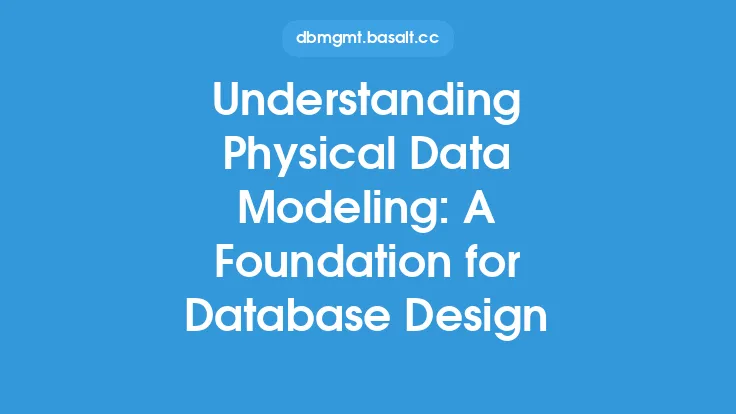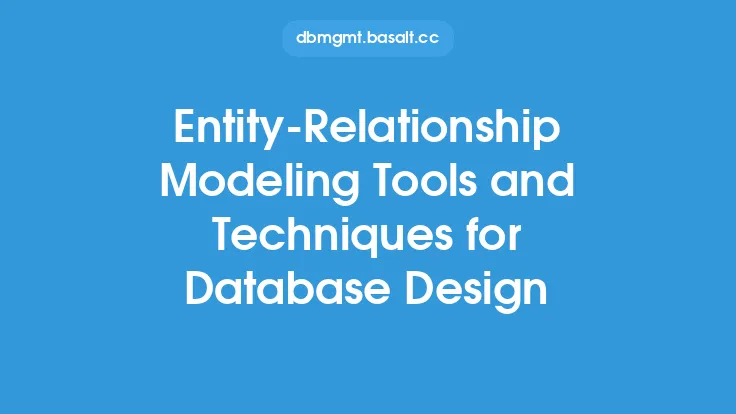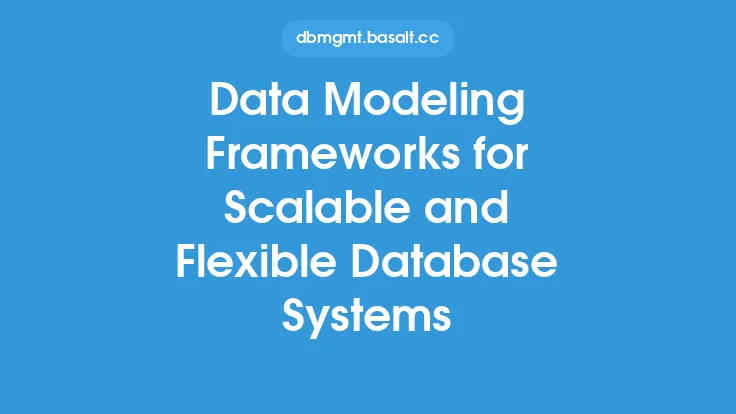Data modeling is a crucial aspect of database design, as it enables organizations to create a conceptual representation of their data assets. A well-designed data model is essential for ensuring data consistency, reducing data redundancy, and improving data integrity. To achieve these goals, it is essential to establish data modeling standards that guide the design of databases. These standards provide a set of rules, guidelines, and best practices that ensure consistency in database design, making it easier to manage and maintain databases over time.
Introduction to Data Modeling Standards
Data modeling standards are a set of guidelines that define how data models should be created, maintained, and updated. These standards cover various aspects of data modeling, including data entity definition, attribute naming, relationship modeling, and data type specification. By establishing data modeling standards, organizations can ensure that their databases are designed consistently, making it easier to integrate data from different sources, improve data quality, and reduce data-related errors. Data modeling standards also facilitate communication among stakeholders, including data architects, database administrators, and business users, by providing a common language and framework for discussing data-related issues.
Benefits of Data Modeling Standards
The benefits of data modeling standards are numerous. Firstly, they ensure consistency in database design, which makes it easier to manage and maintain databases over time. Consistent database design also improves data quality, reduces data redundancy, and enhances data integrity. Secondly, data modeling standards facilitate data integration, making it easier to combine data from different sources and create a unified view of the organization's data assets. Thirdly, data modeling standards improve communication among stakeholders, reducing misunderstandings and errors that can arise from inconsistent data models. Finally, data modeling standards enable organizations to create a data architecture that is scalable, flexible, and adaptable to changing business needs.
Key Components of Data Modeling Standards
Data modeling standards typically consist of several key components, including data entity definition, attribute naming, relationship modeling, and data type specification. Data entity definition involves identifying and defining the key entities that are relevant to the organization's business operations, such as customers, products, and orders. Attribute naming involves specifying the names and definitions of the attributes that describe each entity, such as customer name, address, and phone number. Relationship modeling involves defining the relationships between entities, such as the relationship between a customer and an order. Data type specification involves defining the data types that are used to store each attribute, such as integer, string, or date.
Data Entity Definition
Data entity definition is a critical component of data modeling standards. It involves identifying and defining the key entities that are relevant to the organization's business operations. Each entity should have a unique name and definition, and should be described in terms of its attributes and relationships with other entities. For example, a customer entity might be defined as follows: "A customer is an individual or organization that purchases products or services from the company. The customer entity has the following attributes: customer ID, name, address, phone number, and email address." By defining entities in a consistent and rigorous way, organizations can ensure that their databases are designed to support their business operations effectively.
Attribute Naming
Attribute naming is another important component of data modeling standards. It involves specifying the names and definitions of the attributes that describe each entity. Attribute names should be unique, concise, and descriptive, and should follow a consistent naming convention. For example, an organization might use a naming convention that requires attribute names to be in uppercase, with each word separated by an underscore. By following a consistent naming convention, organizations can ensure that their attribute names are easy to understand and use. Attribute definitions should also be provided, to ensure that the meaning and purpose of each attribute are clear.
Relationship Modeling
Relationship modeling is a critical component of data modeling standards. It involves defining the relationships between entities, such as the relationship between a customer and an order. There are several types of relationships that can exist between entities, including one-to-one, one-to-many, and many-to-many relationships. For example, a customer can place many orders, but each order is associated with only one customer. By defining relationships in a consistent and rigorous way, organizations can ensure that their databases are designed to support their business operations effectively.
Data Type Specification
Data type specification is an important component of data modeling standards. It involves defining the data types that are used to store each attribute, such as integer, string, or date. Data types should be chosen based on the requirements of the attribute, and should be consistent across the database. For example, an organization might specify that all date attributes should be stored as datetime values, while all string attributes should be stored as varchar values. By following a consistent data type specification, organizations can ensure that their databases are designed to support their business operations effectively, and that data is stored in a way that is efficient and scalable.
Implementing Data Modeling Standards
Implementing data modeling standards requires a structured approach. Firstly, organizations should establish a data modeling team, consisting of data architects, database administrators, and business users. This team should be responsible for developing and maintaining the data modeling standards, and for ensuring that they are followed consistently across the organization. Secondly, organizations should develop a data modeling methodology, which outlines the steps and procedures that should be followed when creating and maintaining data models. This methodology should include guidelines for data entity definition, attribute naming, relationship modeling, and data type specification. Finally, organizations should provide training and support to ensure that all stakeholders understand and follow the data modeling standards.
Tools and Techniques for Data Modeling
There are several tools and techniques that can be used to support data modeling, including data modeling software, entity-relationship diagrams, and data dictionaries. Data modeling software provides a graphical interface for creating and maintaining data models, and can include features such as data entity definition, attribute naming, and relationship modeling. Entity-relationship diagrams provide a visual representation of the relationships between entities, and can be used to communicate data models to stakeholders. Data dictionaries provide a centralized repository for storing and managing data models, and can include features such as data entity definition, attribute naming, and data type specification. By using these tools and techniques, organizations can ensure that their data models are accurate, complete, and consistent.
Best Practices for Data Modeling
There are several best practices that should be followed when creating and maintaining data models. Firstly, data models should be developed in a iterative and incremental way, with continuous feedback and refinement. Secondly, data models should be based on a thorough understanding of the organization's business operations and requirements. Thirdly, data models should be designed to be flexible and adaptable, with the ability to evolve over time. Fourthly, data models should be communicated effectively to stakeholders, using techniques such as entity-relationship diagrams and data dictionaries. Finally, data models should be maintained and updated regularly, to ensure that they remain accurate and relevant. By following these best practices, organizations can ensure that their data models are effective, efficient, and scalable.
Conclusion
In conclusion, data modeling standards are a critical component of database design, as they enable organizations to create a conceptual representation of their data assets. By establishing data modeling standards, organizations can ensure consistency in database design, improve data quality, reduce data redundancy, and enhance data integrity. The key components of data modeling standards include data entity definition, attribute naming, relationship modeling, and data type specification. By following a structured approach to implementing data modeling standards, and by using tools and techniques such as data modeling software and entity-relationship diagrams, organizations can ensure that their data models are accurate, complete, and consistent. By following best practices for data modeling, organizations can ensure that their data models are effective, efficient, and scalable, and that they support their business operations effectively.





